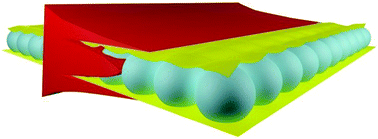Sandwiched gold/PNIPAm/gold microstructures for smart plasmonics application: towards the high detection limit and Raman quantitative measurements†
Abstract
A smart plasmonic sensor, comprising a layer of a stimuli-responsive polymer sandwiched between two gold layers, is reported. As a stimuli-responsive material, a monolayer of poly(N-isopropylacrylamide) (PNIPAm) crosslinked globules is used. A quasi-periodic structure of the top gold layer facilitates efficient excitation and serves as a support for plasmon excitation and propagation. The intermediate layer of PNIPAm efficiently entraps targeted molecules from solutions. The sensor structure was optimized for efficient light focusing in the “active” PNIPAm layer. The optimization was based on the time-resolved finite-element simulations, which take into account the thickness of gold layers, size of PNIPAm globules and Raman excitation wavelength (780 nm). The prepared structures were characterized using SEM, AFM, UV-Vis refractometry and goniometry. Additional AFM scans were performed in water at two temperatures corresponding to the collapsed and swollen PNIPAm states. The Raman measurements demonstrate a high detection limit and perfect reproducibility of the Raman scattering signal for the prepared sensor. In addition, the use of created SERS structures for the detection of relevant molecules in the medical, biological and safety fields was demonstrated.

- This article is part of the themed collection: Bioanalytical Sensors


 Please wait while we load your content...
Please wait while we load your content...